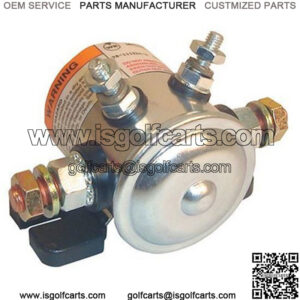What are the symptoms of a bad solenoid on a golf cart?
In a gas golf cart, the larger contacts could fail to release, which means the starter will be operating even if you turn the ignition switch to off. In addition, the spring that pulls the pinion back to its resting position could wear down leaving the starter engaged continuously. (Starters are supposed to get the flywheel moving, then back out of position – disengage.)
Like any switch that relies on wiring, the solenoid could also just wear out due to overheating. This might cause it to fail to retrieve the pinion gear.
Knowing that, when the solenoid starts failing, how do you know it and what’s going on?
On a gas golf cart, the most common symptom is the starter failing to engage – so the engine doesn’t turn over – while all you hear a series of very futile clicking sounds.
On an electric golf cart, the most common symptom is the solenoid is not delivering electricity to the controller when the vehicle’s ignition is turned on. In normal operating conditions, the solenoid clicks on and off with the ignition switch. A failing solenoid will generally not click.
Two things could be going on here. The solenoid might not be getting enough electricity to do its work – which could be caused by loose connections, a weak battery or the coil wearing out.
Secondly, the contacts could begin to wear out from overheating or exposure to high levels of current. This needs to be fixed right away if possible, because this causes continuous use of the starter. If not caught in time, the solenoid and the starter will both need replacement.
How to test for a bad solenoid in your golf cart
If you’re a do-it-yourself-er (of course you are), here’s what you can do.
Before starting work, a couple of items/tools will be recommended prior to starting. The list is as follows:
- a multimeter or voltmeter
- a 1/2” or similar in size wrench
- gloves
- electrical tape
- safety glasses

